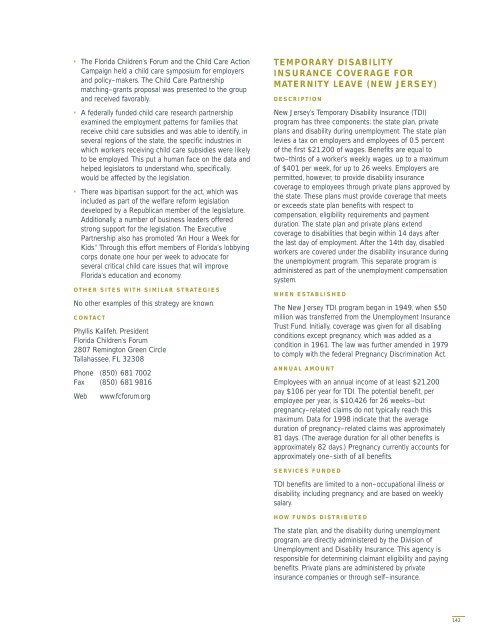Financing Child Care in the United States - Ewing Marion Kauffman ...
Financing Child Care in the United States - Ewing Marion Kauffman ...
Financing Child Care in the United States - Ewing Marion Kauffman ...
You also want an ePaper? Increase the reach of your titles
YUMPU automatically turns print PDFs into web optimized ePapers that Google loves.
• The Florida <strong>Child</strong>ren’s Forum and <strong>the</strong> <strong>Child</strong> <strong>Care</strong> Action<br />
Campaign held a child care symposium for employers<br />
and policy–makers. The <strong>Child</strong> <strong>Care</strong> Partnership<br />
match<strong>in</strong>g–grants proposal was presented to <strong>the</strong> group<br />
and received favorably.<br />
• A federally funded child care research partnership<br />
exam<strong>in</strong>ed <strong>the</strong> employment patterns for families that<br />
receive child care subsidies and was able to identify, <strong>in</strong><br />
several regions of <strong>the</strong> state, <strong>the</strong> specific <strong>in</strong>dustries <strong>in</strong><br />
which workers receiv<strong>in</strong>g child care subsidies were likely<br />
to be employed. This put a human face on <strong>the</strong> data and<br />
helped legislators to understand who, specifically,<br />
would be affected by <strong>the</strong> legislation.<br />
• There was bipartisan support for <strong>the</strong> act, which was<br />
<strong>in</strong>cluded as part of <strong>the</strong> welfare reform legislation<br />
developed by a Republican member of <strong>the</strong> legislature.<br />
Additionally, a number of bus<strong>in</strong>ess leaders offered<br />
strong support for <strong>the</strong> legislation. The Executive<br />
Partnership also has promoted “An Hour a Week for<br />
Kids.” Through this effort members of Florida’s lobby<strong>in</strong>g<br />
corps donate one hour per week to advocate for<br />
several critical child care issues that will improve<br />
Florida’s education and economy.<br />
OTHER SITES WITH SIMILAR STRATEGIES<br />
No o<strong>the</strong>r examples of this strategy are known.<br />
CONTACT<br />
Phyllis Kalifeh, President<br />
Florida <strong>Child</strong>ren’s Forum<br />
2807 Rem<strong>in</strong>gton Green Circle<br />
Tallahassee, FL 32308<br />
Phone (850) 681 7002<br />
Fax (850) 681 9816<br />
Web<br />
www.fcforum.org<br />
TEMPORARY DISABILITY<br />
INSURANCE COVERAGE FOR<br />
MATERNITY LEAVE (NEW JERSEY)<br />
DESCRIPTION<br />
New Jersey’s Temporary Disability Insurance (TDI)<br />
program has three components: <strong>the</strong> state plan, private<br />
plans and disability dur<strong>in</strong>g unemployment. The state plan<br />
levies a tax on employers and employees of 0.5 percent<br />
of <strong>the</strong> first $21,200 of wages. Benefits are equal to<br />
two–thirds of a worker’s weekly wages, up to a maximum<br />
of $401 per week, for up to 26 weeks. Employers are<br />
permitted, however, to provide disability <strong>in</strong>surance<br />
coverage to employees through private plans approved by<br />
<strong>the</strong> state. These plans must provide coverage that meets<br />
or exceeds state plan benefits with respect to<br />
compensation, eligibility requirements and payment<br />
duration. The state plan and private plans extend<br />
coverage to disabilities that beg<strong>in</strong> with<strong>in</strong> 14 days after<br />
<strong>the</strong> last day of employment. After <strong>the</strong> 14th day, disabled<br />
workers are covered under <strong>the</strong> disability <strong>in</strong>surance dur<strong>in</strong>g<br />
<strong>the</strong> unemployment program. This separate program is<br />
adm<strong>in</strong>istered as part of <strong>the</strong> unemployment compensation<br />
system.<br />
WHEN ESTABLISHED<br />
The New Jersey TDI program began <strong>in</strong> 1949, when $50<br />
million was transferred from <strong>the</strong> Unemployment Insurance<br />
Trust Fund. Initially, coverage was given for all disabl<strong>in</strong>g<br />
conditions except pregnancy, which was added as a<br />
condition <strong>in</strong> 1961. The law was fur<strong>the</strong>r amended <strong>in</strong> 1979<br />
to comply with <strong>the</strong> federal Pregnancy Discrim<strong>in</strong>ation Act.<br />
ANNUAL AMOUNT<br />
Employees with an annual <strong>in</strong>come of at least $21,200<br />
pay $106 per year for TDI. The potential benefit, per<br />
employee per year, is $10,426 for 26 weeks—but<br />
pregnancy–related claims do not typically reach this<br />
maximum. Data for 1998 <strong>in</strong>dicate that <strong>the</strong> average<br />
duration of pregnancy–related claims was approximately<br />
81 days. (The average duration for all o<strong>the</strong>r benefits is<br />
approximately 82 days.) Pregnancy currently accounts for<br />
approximately one–sixth of all benefits.<br />
SERVICES FUNDED<br />
TDI benefits are limited to a non–occupational illness or<br />
disability, <strong>in</strong>clud<strong>in</strong>g pregnancy, and are based on weekly<br />
salary.<br />
HOW FUNDS DISTRIBUTED<br />
The state plan, and <strong>the</strong> disability dur<strong>in</strong>g unemployment<br />
program, are directly adm<strong>in</strong>istered by <strong>the</strong> Division of<br />
Unemployment and Disability Insurance. This agency is<br />
responsible for determ<strong>in</strong><strong>in</strong>g claimant eligibility and pay<strong>in</strong>g<br />
benefits. Private plans are adm<strong>in</strong>istered by private<br />
<strong>in</strong>surance companies or through self–<strong>in</strong>surance.<br />
142
















